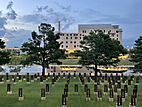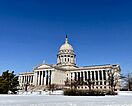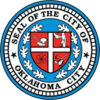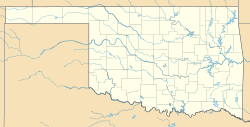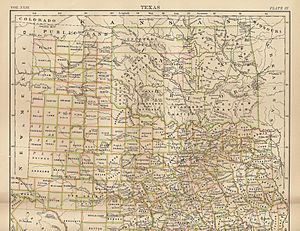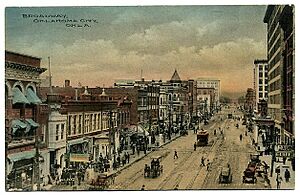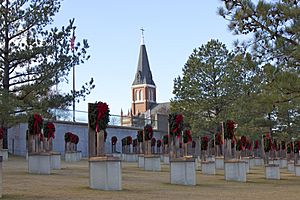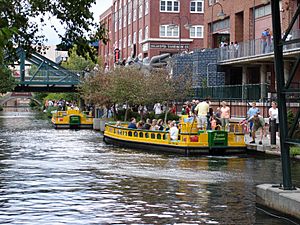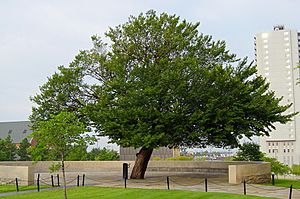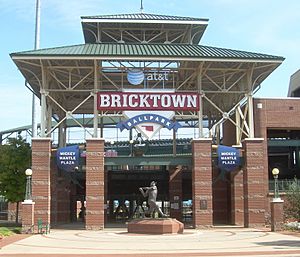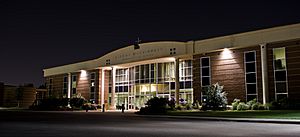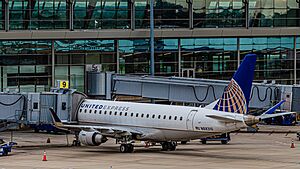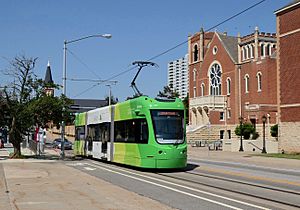Oklahoma City facts for kids
Quick facts for kids
Oklahoma City
|
|||
|---|---|---|---|
|
Oklahoma City Hall
Skydance Bridge
Convention Center
|
|||
|
|||
| Nickname(s):
"OKC", "The 405", "Oklas", "Boomtown", "The Big Friendly", "The City",
|
|||
| Country | United States | ||
| State | Oklahoma | ||
| Counties | |||
| Founded | April 22, 1889 | ||
| Incorporated | July 15, 1890 | ||
| Government | |||
| • Type | Council–manager | ||
| • Body | Oklahoma City Council | ||
| Area | |||
| • City | 620.79 sq mi (1,607.83 km2) | ||
| • Land | 606.48 sq mi (1,570.77 km2) | ||
| • Water | 14.31 sq mi (37.06 km2) | ||
| • Urban | 421.73 sq mi (1,092.3 km2) | ||
| Elevation | 1,198 ft (365 m) | ||
| Population
(2020)
|
|||
| • City | 681,054 |
||
| • Rank | 62nd in North America 20th in the United States 1st in Oklahoma |
||
| • Density | 1,122.96/sq mi (433.58/km2) | ||
| • Urban | 982,276 (US: 46th) | ||
| • Urban density | 2,329.2/sq mi (899.3/km2) | ||
| • Metro | 1,441,695 (US: 42nd) | ||
| Demonym(s) |
|
||
| GDP | |||
| • Metro | $100.054 billion (2023) | ||
| Time zone | UTC−6 (Central (CST)) | ||
| • Summer (DST) | UTC−5 (CDT) | ||
| ZIP Codes |
Zip codes
|
||
| Area code(s) | 405/572 | ||
| FIPS code | 40-55000 | ||
| GNIS feature ID | 1102140 | ||
Oklahoma City (![]() i/ˌoʊkləˈhoʊmə -/), often called OKC, is the capital and largest city in the state of Oklahoma. It's also the main city of Oklahoma County. In 2020, over 681,000 people lived here, making it the 20th largest city in the United States. The bigger Oklahoma City area has more than 1.4 million people.
i/ˌoʊkləˈhoʊmə -/), often called OKC, is the capital and largest city in the state of Oklahoma. It's also the main city of Oklahoma County. In 2020, over 681,000 people lived here, making it the 20th largest city in the United States. The bigger Oklahoma City area has more than 1.4 million people.
Oklahoma City is quite large, stretching into nearby counties like Canadian, Cleveland, and Pottawatomie. It's one of the biggest cities in the U.S. by land area.
The city is known for its huge livestock market. Oil, natural gas, and related businesses are also very important to its economy. You can even see oil derricks (oil drilling machines) on the grounds of the State Capitol building! The U.S. government is also a big employer, with many people working at Tinker Air Force Base and the Federal Aviation Administration (FAA) center.
Oklahoma City is a major travel spot because it sits on important highways like I-35 and I-40. These roads connect it to cities like Dallas, Kansas City, and Memphis. The city was founded very quickly during the Land Run of 1889, with over 10,000 people settling there in just a few hours.
Sadly, Oklahoma City was also the site of a terrible event on April 19, 1995. A bomb exploded at the Alfred P. Murrah Federal Building, causing many deaths and injuries. This was a very sad day for the city.
Oklahoma City is also famous for its weather, especially tornadoes. Since 1890, 14 powerful tornadoes have hit the city, some of them being the strongest ever recorded.
Contents
History of Oklahoma City
| Native American names for Oklahoma City |
| Choctaw: Tʋmaha chito Oklahumma |
| Cherokee: ᎣᎦᎳᎰᎹ ᎦᏚᎲᎢ |
| Romanized: ogalahoma gaduhvi |
| Cheyenne: Ma'xepóno'e |
| Comanche: Pia Sooka̠hni |
| Delaware: Oklahoma-utènaii |
| Iowa-Oto: Chína Chége Itúⁿ |
| Navajo: Halgai Hóteeldi Kin Haalʼáhí |
| Meskwaki: Okonohômîheki |
Oklahoma City began on April 22, 1889, during an event called "The Land Run." This was when a large area of land was opened for people to settle. Just four days later, the city elected its first mayor, William Couch. About 10,000 settlers quickly moved into the area. The city grew very fast, doubling its population between 1890 and 1900.
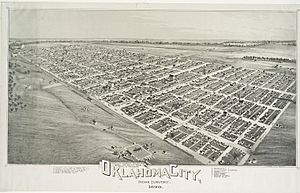
By 1907, when Oklahoma became a state, Oklahoma City was bigger and more important than Guthrie, which was the capital at the time. Soon after, the capital was moved to Oklahoma City. In the early 1900s, Oklahoma City was a key stop on the famous Route 66.
Before World War II, Oklahoma City became a major center for the meat packing industry. In 1928, oil was discovered right within the city limits, even under the State Capitol building! This made Oklahoma City a big player in oil production. After the war, the city grew even more with the building of the Interstate Highway System. This made Oklahoma City a major meeting point for three big interstates: I-35, I-40, and I-44.
In 1959, the city greatly expanded its size, becoming one of the largest U.S. cities by land area. In 1971, Patience Latting became the first female mayor of Oklahoma City. She was also the first woman to lead a U.S. city with over 350,000 people.
Like many cities, Oklahoma City's downtown population went down in the 1970s and 1980s. People moved to the suburbs because of new highways and housing. City projects tried to fix this, but many older buildings were removed, leaving empty lots. One success was the building of the Myriad Gardens and Crystal Bridge, a beautiful indoor garden downtown.
In 1993, the city started a huge plan called MAPS to rebuild downtown. This plan added a new baseball park, a central library, and a water canal in the Bricktown entertainment area. You can even ride water taxis there! MAPS has been very successful, bringing in lots of new businesses and people to live downtown.
On April 19, 1995, Oklahoma City faced a terrible tragedy when a bomb exploded at the Alfred P. Murrah Federal Building. The building was destroyed, and 168 people lost their lives. Today, the site is the Oklahoma City National Memorial, a place to remember the victims, survivors, and rescuers. It's a quiet place for reflection and learning.
The city also has a "Core-to-Shore" project. This plan moved a major highway (I-40) to create a new park and connect the downtown area to the Oklahoma River.
Geography and Climate

Oklahoma City is located in the middle of Oklahoma, in a region called "Frontier Country." This central location is great for the state government. The city is also a key point for travel to Texas and Mexico.
The city covers a large area, with much of it being land and some water. It sits in a region with rolling hills and oak trees. The North Canadian River, now called the Oklahoma River within the city, flows through Oklahoma City. Years ago, this river used to flood often. Now, dams help control the water level. The city also has three large lakes: Lake Hefner, Lake Overholser, and the biggest, Lake Stanley Draper.
Oklahoma City has a humid subtropical climate, which means it has hot, humid summers and cool winters. Strong winds are common, helping to cool things down in summer and making winters feel colder. Sometimes, there are severe ice storms and snowstorms in winter.
Extreme Weather in Oklahoma City
Oklahoma City is in "Tornado Alley" and experiences an active severe weather season, especially from March to June. Tornadoes, severe hailstorms, and strong windstorms called derechoes are common. Tornadoes can happen any month, but they are most frequent in spring and sometimes in autumn. The Oklahoma City area is one of the most tornado-prone major cities in the world. Since 1890, about 150 tornadoes have hit the city.
On May 3, 1999, a powerful tornado, rated F5 (the highest level), hit parts of Oklahoma City. Wind speeds were measured at an incredible 318 miles per hour, the fastest ever recorded on Earth! Another very strong tornado, rated EF5, struck on May 20, 2013, affecting South Oklahoma City, Newcastle, and Moore. Less than two weeks later, on May 31, 2013, the widest tornado ever recorded (2.6 miles wide) formed near El Reno, heading towards Oklahoma City before it disappeared.
Population and People
| Population of Oklahoma City 1890-2022 | |||
|---|---|---|---|
| Census | Pop. | %± | |
| 1890 | 4,151 | — | |
| 1900 | 10,037 | 141.8% | |
| 1910 | 64,205 | 539.7% | |
| 1920 | 91,295 | 42.2% | |
| 1930 | 185,389 | 103.1% | |
| 1940 | 204,424 | 10.3% | |
| 1950 | 243,504 | 19.1% | |
| 1960 | 324,253 | 33.2% | |
| 1970 | 368,164 | 13.5% | |
| 1980 | 404,014 | 9.7% | |
| 1990 | 444,719 | 10.1% | |
| 2000 | 506,132 | 13.8% | |
| 2010 | 579,999 | 14.6% | |
| 2020 | 681,054 | 17.4% | |
| 2023 (est.) | 702,767 | 21.2% | |
| U.S. Decennial Census 1790-1960 1900-1990 1990-2000 2010 |
|||
In 2010, Oklahoma City had almost 580,000 people. By 2020, its population grew to over 681,000! This makes it the first city in Oklahoma and the Great Plains region to have more than 600,000 residents.
The city's population is very diverse. In 2020, about half of the people were White, and a growing number were Hispanic or Latino (over 21%). There are also many Black, Asian, and Native American residents. Oklahoma City is known for being one of the least racially segregated large cities in the U.S.
Economy and Jobs
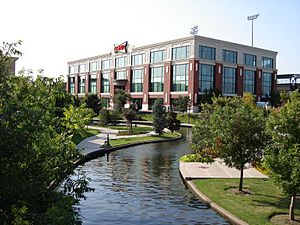
Oklahoma City's economy used to be mainly about government and oil. But now, it has many different types of businesses, including technology, health care, and services. The city is home to the headquarters of two very large companies, Expand Energy and Devon Energy. It also hosts Love's Travel Stops & Country Stores, a huge private company.
Many people work for the State of Oklahoma and at Tinker Air Force Base. Other big employers include health care systems like Integris Health and Mercy Health Center, and companies like Amazon and Hobby Lobby Stores. The city's economy has grown a lot, showing how much it has changed and diversified.
Tourism in OKC
Tourism is a big part of Oklahoma City's economy. About 23 million visitors come to the city each year, spending billions of dollars. This supports almost 34,000 jobs and brings in a lot of tax money for the state and local government.
Culture and Fun
Museums and Theaters
The Oklahoma City Museum of Art is a great place to see art, including a huge collection of glass sculptures by artist Dale Chihuly. It also has a theater that shows different kinds of movies. The Civic Center Music Hall hosts performances by the Oklahoma City Ballet, Opera, and Philharmonic, plus traveling Broadway shows.
The Oklahoma Contemporary Arts Center offers art exhibitions, classes, and workshops. If you love science, the Science Museum Oklahoma has cool exhibits and an IMAX theater. For something unique, visit the Museum of Osteology to see over 450 real skeletons!
The National Cowboy & Western Heritage Museum celebrates the history and art of the American West. In 2021, the First Americans Museum opened, sharing the rich histories and cultures of Oklahoma's many Native American tribes.
The Oklahoma City National Memorial is a very important place. It honors everyone affected by the 1995 bombing. You can visit the outdoor memorial anytime for free, and there's a museum to learn more. The American Banjo Museum in Bricktown shows the history of the banjo and its music. The Oklahoma History Center tells the story of Oklahoma from ancient times to today.
Restaurants in OKC
Oklahoma City has some amazing restaurants! Florence's Restaurant was recognized as one of "America's Classics" by the James Beard Foundation, a big honor in the food world. Chef Andrew Black also won a James Beard Award for Best Chef Southwest in 2023.
The TV show Diners, Drive-Ins, and Dives has visited several local favorites, including Cattlemen's Steakhouse and Florence's Restaurant.
Sports in Oklahoma City
Oklahoma City is home to several professional sports teams! The most famous is the Oklahoma City Thunder of the National Basketball Association (NBA). The Thunder moved here from Seattle in 2008 and quickly became a popular team. They play their home games at the Paycom Center downtown.
Other professional teams include:
- The Oklahoma City Comets, a Triple-A baseball team linked to the Los Angeles Dodgers. They play at the Chickasaw Bricktown Ballpark.
- The Oklahoma City Energy FC, a soccer team in the United Soccer League.
- The Oklahoma City Spark, a professional softball team.
The Paycom Center also hosts concerts and other big events. The city is proud to host the World Cup of Softball and the NCAA Women's College World Series every year. Major universities like the University of Oklahoma and Oklahoma State University also play important games here.
Oklahoma City Thunder Basketball
The Oklahoma City Thunder joined the NBA in the 2008–09 season. They quickly became one of the top teams in the Western Conference. In 2012, they even made it to the NBA Finals but lost to the Miami Heat. The Thunder has won their division title many times and is known for its exciting play. Their mascot is Rumble the Bison.
Temporary Home for the Hornets
After Hurricane Katrina in 2005, the New Orleans Hornets NBA team temporarily played their home games in Oklahoma City for two seasons. This was the first time an NBA team played regular-season games in Oklahoma.
2028 Olympics in OKC
Oklahoma City will be a part of the 2028 Summer Olympics! Even though the main games are in Los Angeles, Oklahoma City will host two events: canoe slalom and softball. This is because Oklahoma City has excellent venues for these sports, like Riversport OKC and Devon Park.
Parks and Outdoor Fun
One of the most beautiful spots downtown is the Myriad Botanical Gardens, with its amazing Crystal Bridge tropical conservatory. The park also has an amphitheater, a koi pond, a children's garden with a carousel, and trails. In winter, you can even go ice skating!
Just south of the Myriad Gardens is the huge Scissortail Park, which opened in 2021. It has a big lake for paddleboats, a dog park, a concert stage, a playground, and sports areas. It's a popular spot for farmers markets, movies, and festivals.
Oklahoma City has many other parks too. Will Rogers Park has beautiful rose gardens and a butterfly garden. The Mat Hoffman Action Sports Park is a famous skate park named after a local BMX champion.
You can find walking trails along the Bricktown Canal and the Oklahoma River downtown. There are also bike trails around Lake Hefner and Lake Overholser. Lake Stanley Draper is the largest lake, offering a more natural outdoor experience.
The Oklahoma City Zoo and Botanical Garden is home to many animals and beautiful gardens. Next to the zoo is Remington Park, where you can watch horse racing.
Education and Learning
Colleges and Universities
Oklahoma City has several colleges and universities. Oklahoma City University (OCU) is known for its performing arts, law, and athletic programs. The University of Oklahoma has important medical campuses here, including OU Medical Center, which has the state's only Level-One trauma center.
Other colleges include the University of Central Oklahoma in nearby Edmond, Oklahoma Christian University, and Oklahoma City Community College. Langston University is the state's historically black college, with a campus in the city.
Schools for Kids
The Oklahoma City Public Schools district is the largest in the state. Some of its schools, like Classen School of Advanced Studies and Harding Charter Preparatory High School, are highly ranked nationally for their advanced programs.
Because Oklahoma City is so big, parts of many suburban school districts also extend into the city. There are also several private schools, such as Casady School and Heritage Hall School, which are known for their strong academics. The Oklahoma School of Science and Mathematics is a special school for talented math and science students.
Media and News
Print Media
The Oklahoman is the main daily newspaper in Oklahoma City and the most widely read in the state. Oklahoma Gazette is a weekly newspaper that covers local news, reviews, and entertainment. The Journal Record focuses on business news. There are also many community newspapers that serve different ethnic groups in the city.
TV and Radio
Oklahoma City has a long history in broadcasting. WKY Radio was one of the first radio stations west of the Mississippi River, starting in 1921. WKY-TV (channel 4) was also one of the first TV stations to broadcast in color.
Today, all the major U.S. TV networks have local channels in Oklahoma City, including KFOR-TV (NBC), KOCO-TV (ABC), KWTV-DT (CBS), and KOKH-TV (Fox). There are also channels for PBS and Spanish-language networks like Telemundo and Univision.
Getting Around Oklahoma City
Highways and Roads
Oklahoma City is a major hub for the U.S. Interstate Network. Three big interstates – I-35, I-40, and I-44 – all pass through the city. Other important highways include I-235 and I-240. While these roads are important, some parts can be very busy, so it's important to drive carefully.
Major Expressways
- Interstate 35
- Interstate 40
- Interstate 44
- Interstate 235 / U.S. 77
- Interstate 240
- Lake Hefner Parkway
- Airport Road
- Kilpatrick Turnpike
Airports
Oklahoma City has two main airports: Will Rogers World Airport and Wiley Post Airport. Will Rogers World Airport is the busiest commercial airport in Oklahoma. Tinker Air Force Base, a large military air base, is also in southeast Oklahoma City.
Trains and Buses
Amtrak has a train station downtown, offering daily service to Fort Worth and connecting to the national rail network. Greyhound buses also serve the city.
Public Transportation
Embark is Oklahoma City's public transportation system, mainly using buses. The city is working to improve its transit options. In 2009, voters approved a plan called MAPS 3 to fund a modern Oklahoma City Streetcar system downtown. This streetcar system opened in December 2018, connecting areas like Bricktown, Midtown, and Downtown.
International Connections
Sister Cities
Oklahoma City has "sister cities" around the world. These partnerships help promote cultural understanding and exchanges.
 Rio de Janeiro, Brazil
Rio de Janeiro, Brazil Haikou, China
Haikou, China Puebla, Mexico
Puebla, Mexico Piura, Peru
Piura, Peru Kigali, Rwanda
Kigali, Rwanda Ulyanovsk, Russia (currently paused)
Ulyanovsk, Russia (currently paused) Tainan, Taiwan
Tainan, Taiwan Taipei, Taiwan
Taipei, Taiwan Darwin, Australia
Darwin, Australia
Images for kids
See also
 In Spanish: Oklahoma City para niños
In Spanish: Oklahoma City para niños





